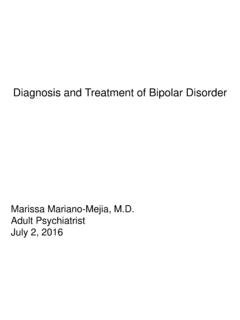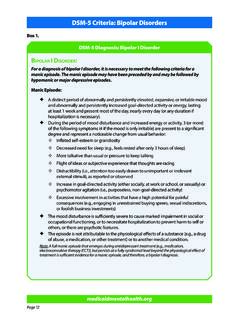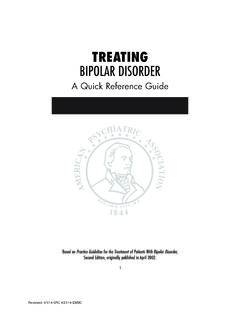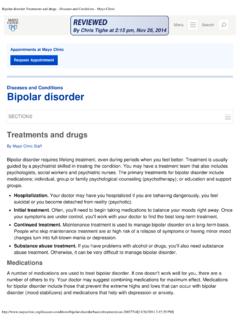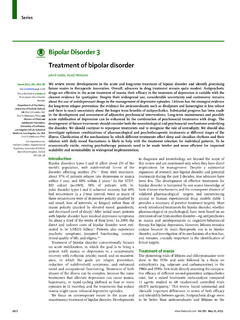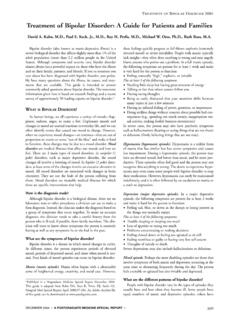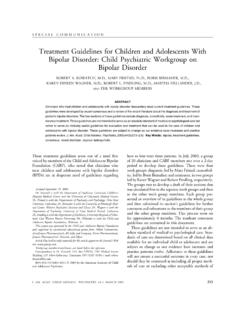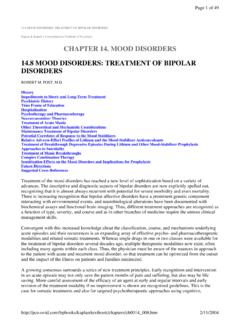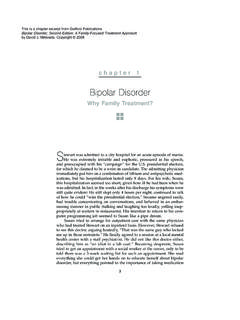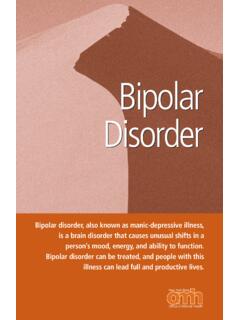Transcription of Preferred Practice Guidelines Bipolar Disorder in Children ...
1 Adoption Date: Revision Dates: September 2013 Review Dates: October 18, 2013 Page1 Preferred Practice GuidelinesBipolar Disorder in Children and Adolescents These Guidelines are based in part on the following: American Academy of Child and Adolescent Psychiatry s Practice Parameter for the Assessment and treatment of Children and Adolescents With Bipolar Disorder , January, 2007. 8567 The Practice Guidelines included in this document are not intended to be required treatment protocols. Physicians and other health professionals must rely on their own expertise in evaluating and treating patients.
2 Practice Guidelines are not a substitute for the best professional judgment of physicians and other health professionals. Behavioral health Guidelines may include commentary developed by the Company s behavioral health committees. Further, while authoritative sources are consulted in the development of these Guidelines , the Practice guideline may differ in some respects from the sources cited. With respect to the issue of coverage, each patient should review his/her Policy or Certificate and Schedule of Benefits for details concerning benefits, procedures and exclusions prior to receiving treatment .
3 The Practice Guidelines do not supersede the Policy or Certificate and Schedule of Benefits. Anthem Blue Cross is the trade name of Blue Cross of California and Anthem Blue Cross Partnership Plan is the trade name of Blue Cross of California Partnership Plan, Inc. Independent licensees of the Blue Cross Association. ANTHEM is a registered trademark of Anthem Insurance Companies, Inc. The Blue Cross name and symbol are registered marks of the Blue Cross Association. Blue Cross of California is contracted with Care Health Plan to provide Medi-Cal Managed Care services in Los Angeles County.
4 Adoption Date: Revision Dates: September 2013 Review Dates: October 18, 2013 Page2 Summary: Although the company maintains a Clinical Practice Guideline for treatment of Bipolar Disorder in adults, the number of adolescents receiving a diagnosis of Bipolar Disorder has increased markedly in the past ten years and research suggests that there are differences in the identification and treatment of the Disorder in adolescents and Children . Rationale: A diagnosis of Bipolar Disorder is made when the required Diagnostic and Statistical Manual of Mental disorders (DSM-IV) target symptoms for mania and mixed state are present, either currently or by history, and other disorders , such as schizophrenia or organic affective disturbances, have been adequately ruled out.
5 Once the diagnosis has been established, it should be reassessed longitudinally to ensure accuracy. Assessment Should Include a Review of: Premorbid history History of present illness Family history and dynamics School information Consultation and collaboration with other mental health and/or social service providers as necessary Past medical history Suicide risk Safety issues Ruling out other disorders and determining if it is necessary to hospitalize Ruling out and including an assessment of adjustment to trauma and PTSD Neuropsychological functioning Substance-induced mood or symptoms
6 Physical evaluation of the child to rule out organic conditions Identifying other pertinent issues that will require ongoing treatment (family dysfunction, school difficulties and comorbid disorders ) When ascertaining the presence or absence of manic symptoms, the frequency, intensity, number, and duration Guidelines are: Frequency: symptoms occurred most days in a week Intensity: symptoms are severe enough to cause extreme disturbance in one domain or moderate disturbance in two or more domains Number: symptoms occur three or four times a day Duration: symptoms occur a total of four or more hours a day, not necessarily contiguous Adoption Date: Revision Dates: September 2013 Review Dates: October 18, 2013 Page3 Lab Values to Obtain: Laboratory and other diagnostic studies should be guided by the psychiatrist s evaluation of the individual s condition and by the choice of pharmacologic treatment .
7 Thyroid function should be assessed in mood disordered patients. Bipolar I Disorder : When diagnosing Bipolar I Disorder in adolescents and Children , the same criteria should be used for adults except that: Mania must be present Euphoria must be present most days, most of the time (for at least seven days) Irritability can be helpful in making a diagnosis if it is episodic or severe, results in impaired function, and is out of keeping or not in character; however, it should not be a core diagnostic criterion Bipolar I Disorder should not be diagnosed solely on the basis of a major depressive episode in an adolescent or child with a family history of Bipolar Disorder ; however, adolescents and Children with a history of depression and a family history of Bipolar Disorder should be carefully monitored for emergence of mania or hypomania.
8 Bipolar II Disorder : In adolescents and Children , the criteria for diagnosing Bipolar II Disorder should normally not be used because the diagnostic criteria are not well-enough established for routine use. In older adolescents, the criteria for diagnosing Bipolar II Disorder in adults should be used. treatment : treatment Goals: Achieve control of acute manic and depressive symptoms Reduce the number of times that mood cycling and mood instability occur Help people with Bipolar Disorder function at the highest level possible Minimize lesser Bipolar symptoms that still could have an impact Minimize side effects of treatment Help people with Bipolar Disorder adhere to their management plan Increase skills in regulation of emotion goals of psychiatric management.
9 Establish and maintain a therapeutic alliance Monitor the individual s psychiatric status Provide patient and family education regarding Bipolar Disorder Promote understanding of and adaptation to the psychosocial effects of Bipolar Disorder Enhance treatment compliance Promote regular patterns of activity and wakefulness Reduce the morbidity and sequelae of the Disorder Adoption Date: Revision Dates: September 2013 Review Dates: October 18, 2013 Page4 Psychotherapeutic treatments: Psychosocial therapy Psychoeducational therapy Psychotherapy (individual, group, family) Cognitive-behavioral therapy treatment of associated disorders or symptoms, such as substance abuse Disorder , depression or suicidality Inpatient admission for acute phase of illness Partial hospitalization or day treatment programs Residential treatment Psychosocial rehabilitation Pharmacotherapy.
10 For mania, mood stabilizers have been the traditional primary mode of Preferred treatment , but second generation antipsychotics have increasing support as an initial treatment in seriously ill Bipolar adolescents. treatment of Episodes: Manic Mood stabilizers and/or SGA s are indicated for manic episodes in Children or adolescents. In addition, at initial presentation: Height and weight should be checked (and monitored regularly afterwards for example, monthly for six months then every six months). When considering an antipsychotic, the risk of metabolic side effects such as weight gain and increased prolactin levels should be considered.







